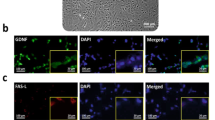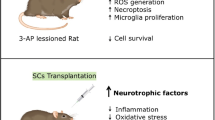Abstract
Brain ischemia is one of the most common causes of death and disability worldwide, which usually happens through diminished blood supply to the tissue. Cell therapy and treatments using trophic factors are some of the new methods to protect brain cells against damage. Specific properties of Sertoli cells (SCs) make them suitable for improving neurological disorders. This study is to evaluate possible neuroprotective effects of SCs transplantation on ischemic damage. Rats were divided into three experimental groups including sham, control, and SCs-treated group. In this study, SCs were isolated from testis of rats and were transplanted into the right striatum by using stereotaxic surgery. After a week, ischemic surgery was performed. Twenty-four hours later, rats were scarified and different regions of the brain including the cortex, the piriform cortex-amygdala (Pir-Amy), and the striatum were collected and preserved in − 80 °C for further investigations. This study demonstrates that SCs transplantation can reduce brain ischemia deficits and increase superoxide dismutase (SOD) and catalase (CAT) activities. It also decreases malondialdehyde production, which is the main product of lipid peroxidation. SCs improve ischemic behavioral disorder and reduce brain edema, blood-brain barrier permeability, and infarct volume. It seems that transplantation of SCs can protect neural cells against ischemia by decreasing oxidative stress.









Similar content being viewed by others
References
Adibhatla RM, Hatcher J (2006) Phospholipase A 2, reactive oxygen species, and lipid peroxidation in cerebral ischemia. Free Radic Biol Med 40(3):376–387
Babu S, Shetty JK, Mungli P (2010) Total thiols and MDA levels in patients with acute myocardial infarction before and after reperfusion therapy. Online J Health Allied Sci 9(3)
Bhat AH, Dar KB, Anees S, Zargar MA, Masood A, Sofi MA, Ganie SA (2015) Oxidative stress, mitochondrial dysfunction and neurodegenerative diseases; a mechanistic insight. Biomed Pharmacother 74:101–110
Bigdeli MR, Hajizadeh S, Froozandeh M, Rasulian B, Heidarianpour A, Khoshbaten A (2007) Prolonged and intermittent normobaric hyperoxia induce different degrees of ischemic tolerance in rat brain tissue. Brain Res 1152:228–233
Borlongan CV, Cameron DF, Saporta S, Sanberg PR (1997) Intracerebral transplantation of testis-derived sertoli cells promotes functional recovery in female rats with 6-hydroxydopamine-induced hemiparkinsonism. Exp Neurol 148(1):388–392
Buege JA, Aust SD (1978) [30] Microsomal lipid peroxidation. Methods Enzymol 52:302–310
Cai J, Chen J, He H, Yin Z, Zhu Z, Yin D (2009) Carbonyl stress: malondialdehyde induces damage on rat hippocampal neurons by disturbance of Ca 2+ homeostasis. Cell Biol Toxicol 25(5):435–445
Cai Y, Liu X, Chen W, Wang Z, Xu G, Zeng Y, Ma Y (2015) TGF-β1 prevents blood–brain barrier damage and hemorrhagic transformation after thrombolysis in rats. Exp Neurol 266:120–126
Caires KC, de Avila J, McLean DJ (2009) Vascular endothelial growth factor regulates germ cell survival during establishment of spermatogenesis in the bovine testis. Reproduction 138(4):667–677
Chao C, Lee EH (1999) Neuroprotective mechanism of glial cell line-derived neurotrophic factor on dopamine neurons: role of antioxidation. Neuropharmacology 38(6):913–916
Chen S-R, Tang J-X, Cheng J-M, Li J, Jin C, Li X-Y, Deng S-L, Zhang Y, Wang X-X, Liu Y-X (2015) Loss of Gata4 in Sertoli cells impairs the spermatogonial stem cell niche and causes germ cell exhaustion by attenuating chemokine signaling. Oncotarget 6(35):37012
Cheng H, Fu YS, Guo JW (2004) Ability of GDNF to diminish free radical production leads to protection against kainate-induced excitotoxicity in hippocampus. Hippocampus 14(1):77–86
Cheng C-Y, Jhao Y-T, Chou T-K, Weng S-J, Huang Y-Y, Yen R-F, Shiue C-Y, Ma K-H (2017) Evaluating the allograft effects of Sertoli cells and embryonic VM tissues in a Parkinsonian rat model using [18F] FE-PE2I/animal-PET. J Nucl Med 58(supplement 1):271
d’Anglemont de Tassigny X, Pascual A, Lopez-Barneo J (2015) GDNF-based therapies, GDNF-producing interneurons, and trophic support of the dopaminergic nigrostriatal pathway. Implications for Parkinson’s disease. Front Neuroanat 9:10
Davis SM, Donnan GA, Parsons MW, Levi C, Butcher KS, Peeters A, Barber PA, Bladin C, De Silva DA, Byrnes G (2008) Effects of alteplase beyond 3 h after stroke in the Echoplanar Imaging Thrombolytic Evaluation Trial (EPITHET): a placebo-controlled randomised trial. Lancet Neurol 7(4):299–309
Deng L, Shi B, Zhuang Y, Chu J, Shi X, Zhang S, Guo M (2014) Performance and mechanism of neuroleukin in the growth and survival of sertoli cell-induced neurons in a coculture system. Cell Transplant 23(3):381–394
Di Pardo A, Luca G, Calafiore R, Maglione V, Favellato M, Amico E, Minelli A, Squitieri F (2014) M19 Sertoli cell transplant: new hope for the treatment of Huntington disease (HD). BMJ Publishing Group, Ltd.
Greenberg DA, Jin K (2013) Vascular endothelial growth factors (VEGFs) and stroke. Cell Mol Life Sci 70(10):1753–1761
Harms KM, Li L, Cunningham LA (2010) Murine neural stem/progenitor cells protect neurons against ischemia by HIF-1α–regulated VEGF signaling. PLoS One 5(3):e9767
Hofmann M-C (2008) Gdnf signaling pathways within the mammalian spermatogonial stem cell niche. Mol Cell Endocrinol 288(1):95–103
Ibáñez CF, Andressoo J-O (2017) Biology of GDNF and its receptors—relevance for disorders of the central nervous system. Neurobiol Dis 97:80–89
Jain M, Rivera S, Monclus EA, Synenki L, Zirk A, Eisenbart J, Feghali-Bostwick C, Mutlu GM, Budinger GS, Chandel NS (2013) Mitochondrial reactive oxygen species regulate transforming growth factor-β signaling. J Biol Chem 288(2):770–777
Keller JN, Mattson MP (1998) Roles of lipid peroxidation in modulation of cellular signaling pathways, cell dysfunction, and death in the nervous system. Rev Neurosci 9(2):105–116
Keller JN, Kindy MS, Holtsberg FW, Clair DKS, Yen H-C, Germeyer A, Steiner SM, Bruce-Keller AJ, Hutchins JB, Mattson MP (1998) Mitochondrial manganese superoxide dismutase prevents neural apoptosis and reduces ischemic brain injury: suppression of peroxynitrite production, lipid peroxidation, and mitochondrial dysfunction. J Neurosci 18(2):687–697
Kiprianova I, Schindowski K, von und Halbach OB, Krause S, Dono R, Schwaninger M, Unsicker K (2004) Enlarged infarct volume and loss of BDNF mRNA induction following brain ischemia in mice lacking FGF-2. Exp Neurol 189(2):252–260
Kobayashi T, Ahlenius H, Thored P, Kobayashi R, Kokaia Z, Lindvall O (2006) Intracerebral infusion of glial cell line-derived neurotrophic factor promotes striatal neurogenesis after stroke in adult rats. Stroke 37(9):2361–2367
Lin Y, Zhang J-C, Fu J, Chen F, Wang J, Wu Z-L, Yuan S-Y (2013) Hyperforin attenuates brain damage induced by transient middle cerebral artery occlusion (MCAO) in rats via inhibition of TRPC6 channels degradation. J Cereb Blood Flow Metab 33(2):253–262
Long J, Cai L, Li J, Zhang L, Yang H, Wang T (2013) JNK3 involvement in nerve cell apoptosis and neurofunctional recovery after traumatic brain injury. Neural Regen Res 8(16):1491
Lopez-Neblina F, Toledo AH, Toledo-Pereyra LH (2005) Molecular biology of apoptosis in ischemia and reperfusion. J Investig Surg 18(6):335–350
Luca G, Bellezza I, Arato I, Di Pardo A, Mancuso F, Calvitti M, Falabella G, Bartoli S, Maglione V, Amico E (2016) Terapeutic potential of microencapsulated Sertoli cells in Huntington disease. CNS Neurosci Ther 22(8):686–690
Malani PN (2012) Harrison’s principles of internal medicine. JAMA 308(17):1813–1814
Manzanero S, Santro T, Arumugam TV (2013) Neuronal oxidative stress in acute ischemic stroke: sources and contribution to cell injury. Neurochem Int 62(5):712–718
Milanizadeh S, Bigdeli MR, Rasoulian B, Amani D (2014) The effects of olive leaf extract on antioxidant enzymes activity and tumor growth in breast cancer. Thrita 3(1)
Mruk DD, Silvestrini B, Mo M-Y, Cheng CY (2002) Antioxidant superoxide dismutase-a review: its function, regulation in the testis, and role in male fertility. Contraception 65(4):305–311
Onténiente B, Rasika S, Benchoua A, Guégan C (2003) Molecular pathways in cerebral ischemia. Mol Neurobiol 27(1):33–72
Qiu S-H, Zhuang H-Y, Zhang H-F, Li C-L (2013) Effects of glial cell-derived neurotrophic factor on SCF protein and antioxidant enzyme activity in the testis of unilateral cryptorchidism rats. Zhonghua nan ke xue 19(7):612–616
Rodriguez AI, Willing AE, Saporta S, Cameron DF, Sanberg PR (2003) Effects of Sertoli cell transplants in a 3-nitropropionic acid model of early Huntington’s disease: a preliminary study. Neurotox Res 5(6):443–450
Sanberg PR, Borlongan CV, Saporta S, Cameron DF (1996) Testis-derived Sertoli cells survive and provide localized immunoprotection for xenografts in rat brain. Nat Biotechnol 14(13):1692
Shah S (2009) Stroke pathophysiology.Foundation for education and research in neurological emergencies
Skinner MK (2005). Sertoli cell secreted regulatory factors. Sertoli Cell Biol 107-120
Smith MP, Cass WA (2007) GDNF reduces oxidative stress in a 6-hydroxydopamine model of Parkinson’s disease. Neurosci Lett 412(3):259–263
Sondell M, Lundborg G, Kanje M (1999) Vascular endothelial growth factor has neurotrophic activity and stimulates axonal outgrowth, enhancing cell survival and Schwann cell proliferation in the peripheral nervous system. J Neurosci 19(14):5731–5740
Sun Y, Jin K, Xie L, Childs J, Mao XO, Logvinova A, Greenberg DA (2003) VEGF-induced neuroprotection, neurogenesis, and angiogenesis after focal cerebral ischemia. J Clin Investig 111(12):1843
Takemoto N, Liu X, Takii K, Teramura Y, Iwata H (2014) Transplantation of co-aggregates of Sertoli cells and islet cells into liver without immunosuppression. Transplantation 97(3):287–293
Thanan R, Oikawa S, Hiraku Y, Ohnishi S, Ma N, Pinlaor S, Yongvanit P, Kawanishi S, Murata M (2014) Oxidative stress and its significant roles in neurodegenerative diseases and cancer. Int J Mol Sci 16(1):193–217
Willing AE, Cameron DF, Sanberg PR (1998) Sertoli cell transplants: their use in the treatment of neurodegenerative disease. Mol Med Today 4(11):471–477
Zhang ZG, Zhang L, Jiang Q, Zhang R, Davies K, Powers C, van Bruggen N, Chopp M (2000) VEGF enhances angiogenesis and promotes blood-brain barrier leakage in the ischemic brain. J Clin Investig 106(7):829
Zhao Y, Zhao B (2013) Oxidative stress and the pathogenesis of Alzheimer’s disease. Oxidative Med Cell Longev 2013
Zhao S, Zhu W, Xue S, Han D (2014) Testicular defense systems: immune privilege and innate immunity. Cell Mol Immunol 11(5):428
Zhu Y, Culmsee C, Klumpp S, Krieglstein J (2004) Neuroprotection by transforming growth factor-β1 involves activation of nuclear factor-κB through phosphatidylinositol-3-OH kinase/Akt and mitogen-activated protein kinase-extracellular-signal regulated kinase1, 2 signaling pathways. Neuroscience 123(4):897–906
Author information
Authors and Affiliations
Corresponding author
Ethics declarations
All experiments were performed upon approval of the Ethics Committee of Shahid Beheshti University, Tehran, Iran.
Rights and permissions
About this article
Cite this article
Milanizadeh, S., Zuwarali, K.N.N., Aliaghaei, A. et al. Therapeutic Potential of Pretreatment with Allograft Sertoli Cells Transplantation in Brain Ischemia by Improving Oxidative Defenses. J Mol Neurosci 64, 533–542 (2018). https://doi.org/10.1007/s12031-018-1054-x
Received:
Accepted:
Published:
Issue Date:
DOI: https://doi.org/10.1007/s12031-018-1054-x




